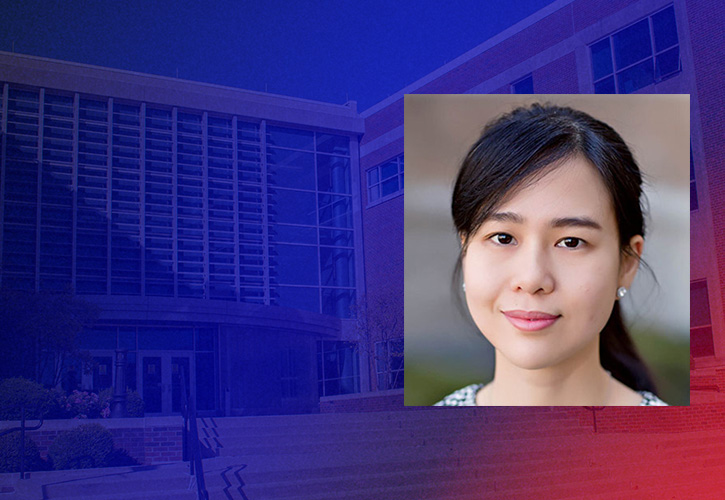College of Arts and Sciences Newsroom

UD researcher leads study using nanotechnology to restore damaged stem cells
By Dave Larsen
A University of Dayton biomedical engineer is the lead author of a study detailing a new strategy by bioengineers at the University of Notre Dame to restore damaged umbilical cord stem cells and enable them to grow new tissues again.
The study published in Communication Biology was co-written by Loan Bui, visiting assistant professor of biology, and her former colleagues at Notre Dame, where she was a postdoctoral research associate from 2018 to 2021.
A newborn’s umbilical cord contains potentially life-saving stem cells that can be used to fight diseases like lymphoma and leukemia. That is why many new parents elect to store (“bank”) their infant’s stem cell-rich umbilical cord blood. But in the 6 to 15 percent of pregnancies affected by gestational diabetes, parents lack this option because the condition damages the stem cells and renders them useless.
Bui and her colleagues used specially engineered nanoparticles to restore the damaged stem cells, allowing them to form new blood vessels. At just 150 nanometers in diameter — about a quarter of the size of a red blood cell — each spherical nanoparticle is able to store medicine and deliver it just to the stem cells themselves by attaching directly onto the stem cells’ surface. Due to their special formulation or “tuning,” the particles release the medicine slowly, making it highly effective even at very low doses.
Donny Hanjaya-Putra, an assistant professor of aerospace and mechanical engineering in the bioengineering graduate program at Notre Dame who directs the lab where the study was conducted, described the process using an analogy. “Each stem cell is like a soldier,” he said. “It is smart and effective; it knows where to go and what to do. But the ‘soldiers’ we are working with are injured and weak. By providing them with this nanoparticle ‘backpack,’ we are giving them what they need to work effectively again.”
The main test for the new “backpack”-equipped stem cells was whether or not they could form new tissues. Hanjaya-Putra and his team tested damaged cells without “backpacks” and observed that they moved slowly and formed imperfect tissues. But when Hanjaya-Putra and his team applied “backpacks,” previously damaged stem cells began forming new blood vessels, both when inserted in synthetic polymers and when implanted under the skin of lab mice, two environments meant to simulate the conditions of the human body.
Although it may be years before this new technique reaches actual health care settings, Hanjaya-Putra explained that it has the clearest path of any method developed so far. “Methods that involve injecting the medicine directly into the bloodstream come with many unwanted risks and side effects,” he said.
In addition, new methods like gene editing face a long journey to Food and Drug Administration (FDA) approval. But Hanjaya-Putra’s technique used only methods and materials already approved for clinical settings by the FDA.
Hanjaya-Putra attributed the study’s success to a highly interdisciplinary group of researchers. “This was a collaboration between chemical engineering, mechanical engineering, biology and medicine — and I always find that the best science happens at the intersection of several different fields.”
As lead researcher, Bui designed and developed the nanoparticle “backpacks” and identified suitable medicine to improve cell migration capacity. She also led a team of graduate and undergraduate students who conducted a variety of studies to characterize the nanoparticles and “backpack”-equipped stem cells, and assess their functionality in both in vitro and animal model settings.
Research collaborators also included stem cell biologist Laura S. Haneline and former postdoctoral fellow Shanique Edwards from the Indiana University School of Medicine; Prakash Nallathamby, research assistant professor of aerospace and mechanical engineering at Notre Dame; and Siyuan Zhang from the University of Texas Southwestern Medical Center.
The researchers hope their approach will be used to restore cells damaged by other types of pregnancy complications, such as preeclampsia. “Instead of discarding the stem cells,” Hanjaya-Putra said, “in the future we hope clinicians will be able to rejuvenate them and use them to regenerate the body. For example, a baby born prematurely due to preeclampsia may have to stay in the NICU with an imperfectly formed lung. We hope our technology can improve this child’s developmental outcomes.”
Bui’s research lab in the UD Department of Biology has been investigating a number of cell migration phenomena in pathology conditions such as cancer metastasis and immune system responses.
“To provide more opportunities for students to participate in biomedical research and innovative investigation, we have recruited and mentored students from different disciplines — including biology, pre-medicine, biochemistry, chemical engineering and health science — and College of Arts and Sciences research programs such as the Dean’s Summer Fellowships and ISE Summer CoRPs,” Bui said. “UD and the biology department have been very supportive of my goal to continue my research mentorship and leadership in order to understand cell migration in-depth and develop novel therapies for treating detrimental diseases such as cancers and diabetes.”
The study was made possible by funding from Notre Dame’s Advancing Our Vision Initiative in Stem Cell Research, Notre Dame’s Science of Wellness Initiative, the Indiana Clinical and Translational Sciences Institute, the American Heart Association and the National Institutes of Health.
Find out more about how Notre Dame conducts non-embryonic stem cell research in accordance with Catholic ethics at https://stemcell.nd.edu/ethics/.
For more information, visit the UD Department of Biology website.
